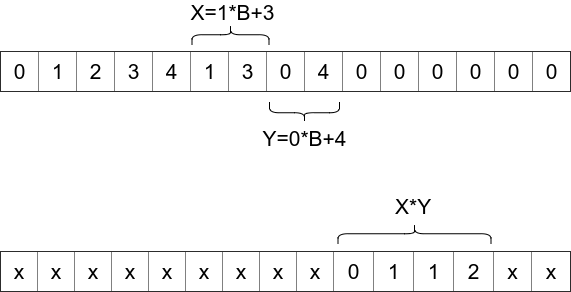---category_name: hardproblem_code: MULDIGproblem_name: 'Multiplication Program'languages_supported:- ADA- ASM- BASH- BF- C- 'C99 strict'- CAML- CLOJ- CLPS- 'CPP 4.3.2'- 'CPP 6.3'- CPP14- CS2- D- ERL- FORT- FS- GO- HASK- ICK- ICON- JAVA- JS- 'LISP clisp'- 'LISP sbcl'- LUA- NEM- NICE- NODEJS- 'PAS fpc'- 'PAS gpc'- PERL- PERL6- PHP- PIKE- PRLG- PYPY- PYTH- 'PYTH 3.5'- RUBY- SCALA- 'SCM chicken'- 'SCM guile'- 'SCM qobi'- ST- TCL- TEXT- WSPCmax_timelimit: '2'source_sizelimit: '50000'problem_author: errichtoproblem_tester: nulldate_added: 1-05-2017tags:- errichto- implementation- july17- medium- simulationeditorial_url: 'https://discuss.codechef.com/problems/MULDIG'time:view_start_date: 1500283800submit_start_date: 1500283800visible_start_date: 1500283800end_date: 1735669800current: 1514816033layout: problem---All submissions for this problem are available.### Read problems statements in [Mandarin Chinese](http://www.codechef.com/download/translated/JULY17/mandarin/MULDIG.pdf), [Russian](http://www.codechef.com/download/translated/JULY17/russian/MULDIG.pdf) and [Vietnamese](http://www.codechef.com/download/translated/JULY17/vietnamese/MULDIG.pdf) as well.Bear Limak hopes you can solve the following problem. You are given an integer **B** which is equal to 3, 5 or 7. Your goal will be to print a sequence of moves that are able to multiply any two 2-digit numbers X and Y in base **B**.Consider a computer memory consisting of 105 cells, numbered 0 through 105-1, each storing one digit (in base **B**, a digit must be between 0 and **B** - 1, inclusive). Let ti denote the digit in the i-th cell. Initially:- ti = i for i B- t**B** and t**B**+1 are digits of the number X, so X = t**B** \* **B** + t**B**+1- t**B**+2 and t**B**+3 are digits of the number Y, so Y = t**B+2** \* **B** + t**B**+3- ti = 0 for all i > **B**+3The first of the two drawings above shows the initial situation for **B** = 5 and multiplying numbers 8 and 4 (represented in base 5 as 13 and 04 respectively). After applying your sequence of moves, the result of the multiplication should be stored in cells **B**+4, **B**+5, **B**+6, **B**+7, which is shown in the second drawing (please note that 8 \* 4 = 32 and this number is represented as 0112 in base 5). Except for those 4 cells containing the answer, the final value of ti doesn't matter. In particular, you are allowed to change values in the first **B+4** cells.You should choose one function F : \[0,**B**-1\] × \[0,**B**-1\] -> \[0,**B**-1\]. It means that the function F should take two digits and return one, where each digit is in the set {0, 1, ..., **B**-1}. One example of F is addition F(x, y) = (x + y) % **B**. We don't require any particular properties from F (e.g. associativity or symmetricity).You should create a sequence of at most 105 moves. In each move, choose three cells c1, c2 and c3, not necessarily distinct. The result of F for digits in cells c1 and c2 will be computed, and then written in the cell c3. In other words, in C++ or Python it's the operation t\[c3\] = F(t\[c1\], t\[c2\]). For every possible pair of 2-digit numbers X and Y, your sequence of moves should produce the correct answer X \* Y as described above.### InputThe only line of the input contains a single integer **B**, denoting the base.### OutputYou should first print the description of the function F that you choose, and then the chosen sequence of moves.First print **B** lines. The i-th line should contain **B** space-separated integers F(i,0), F(i,1), ..., F(i,**B**-1).In the next line, print a single integer K, denoting the number of moves in the sequence.In the i-th of the next K lines, print three space-separated integers c1, c2, c3 (each between 0 and 105-1 inclusive), describing the i-th move.### SubtasksThere are 5 subtasks, each worth 20 points. 1. **B** = 3 and the checker checks only if your program works correctly for X and Y consisting of digits 0 and 1 only (in base **B**).2. **B** = 33. **B** = 54. **B** = 5 and the first digit (in base **B**) of X and the first digit of Y are both 0. In other words: X, Y B.5. **B** = 7### Example<pre><b>Input:</b>3<b>Output (please note that it's incorrect):</b>1 1 22 2 20 1 021 6 70 0 0</pre>### ExplanationThe provided output has valid formatting but isn't correct. Let's analyze the printed moves to multiply X = 7 and Y = 5. These X and Y in base 3 are 21 and 12 respectively, so the initial numbers in cells are: 0, 1, 2, 2, 1, 1, 2, 0, 0, ...The first operation is t\[7\] = F(t\[1\], t\[6\]) = F(1, 2) = 2, so now we have cells: 0, 1, 2, 2, 1, 1, 2, **2**, 0, ...The second operation is t\[0\] = F(t\[0\], t\[0\]) = F(0, 0) = 1, so we will have: **1**, 1, 2, 2, 1, 1, 2, 2, 0, ...After those two operations, cells 7, 8, 9, 10 should contain the product X \* Y = 35, while in fact the contain digits 2, 0, 0, 0, what represents a number 2 \* 33 = 2 \* 27 = 54. The printed sequence of moves should correctly multiply any two 2-digit numbers X, Y, so this particular output would get verdict Wrong Answer.